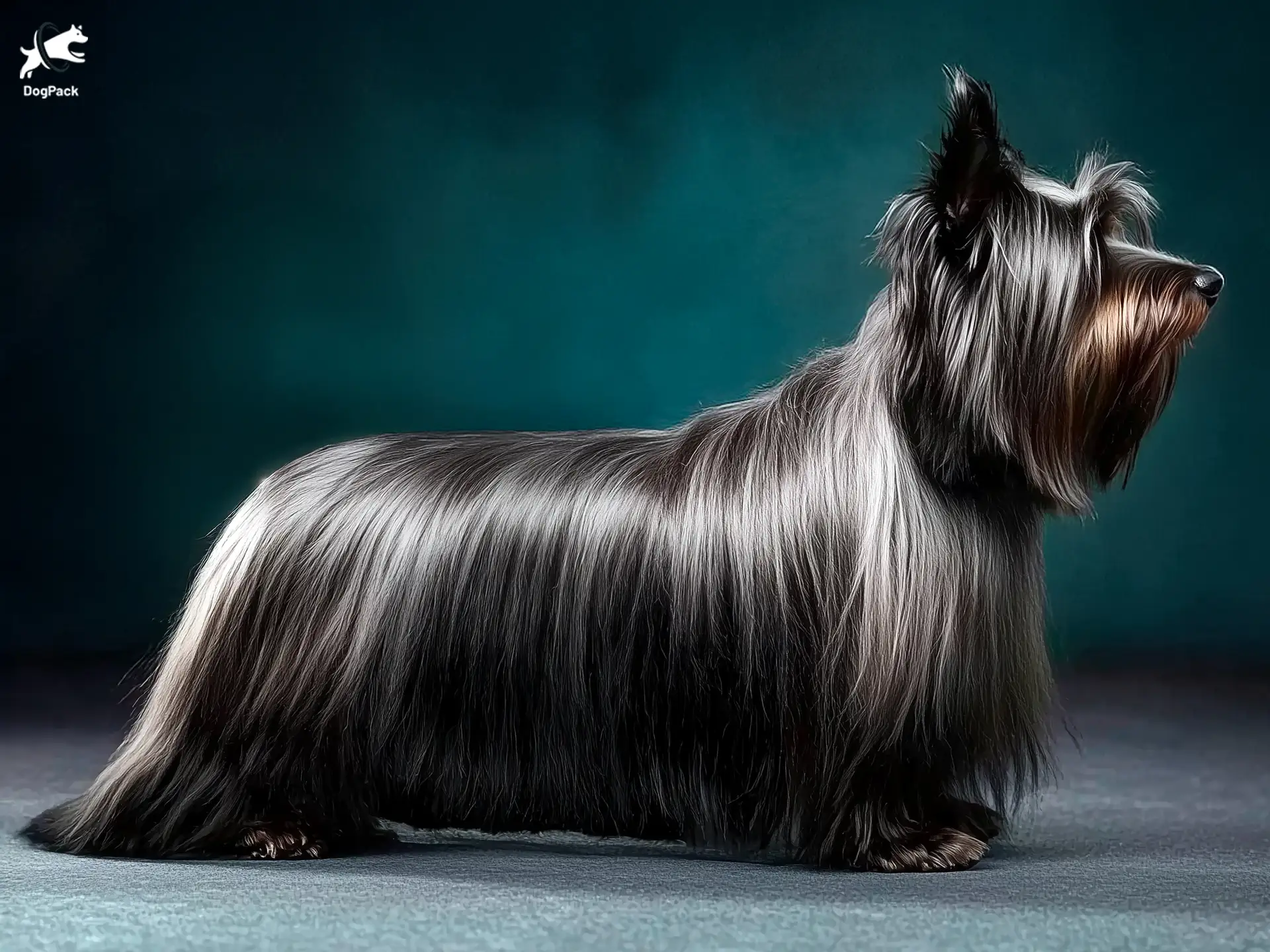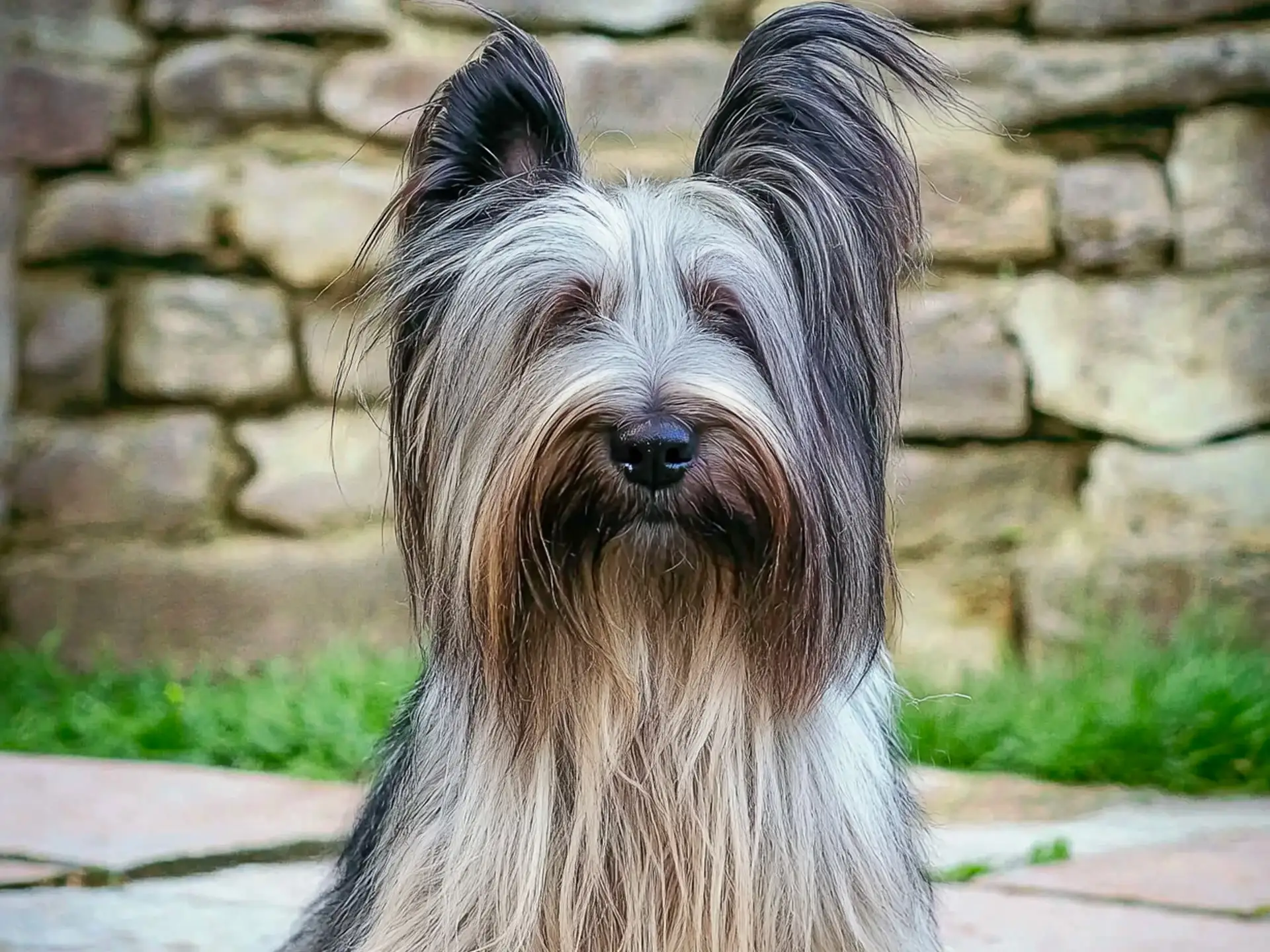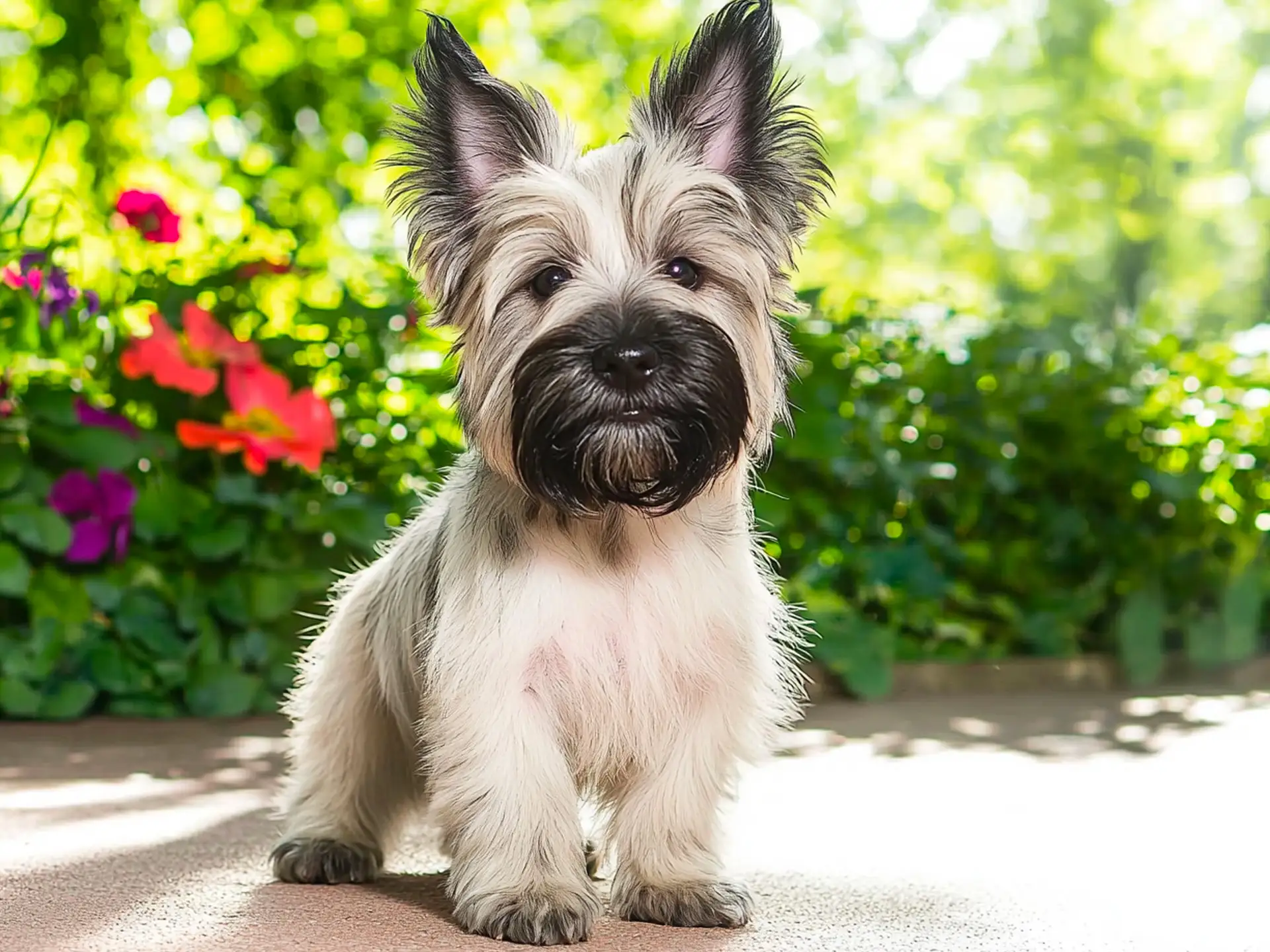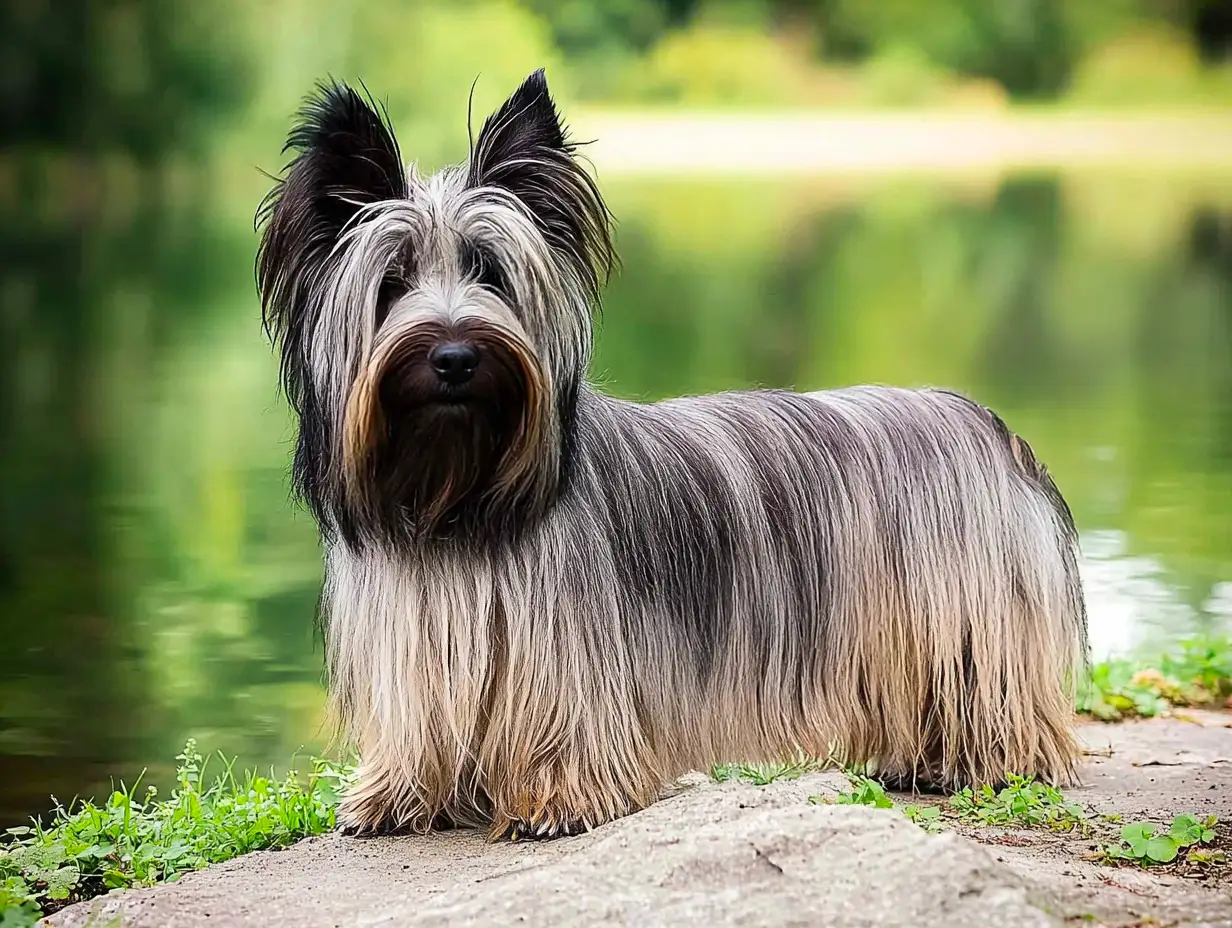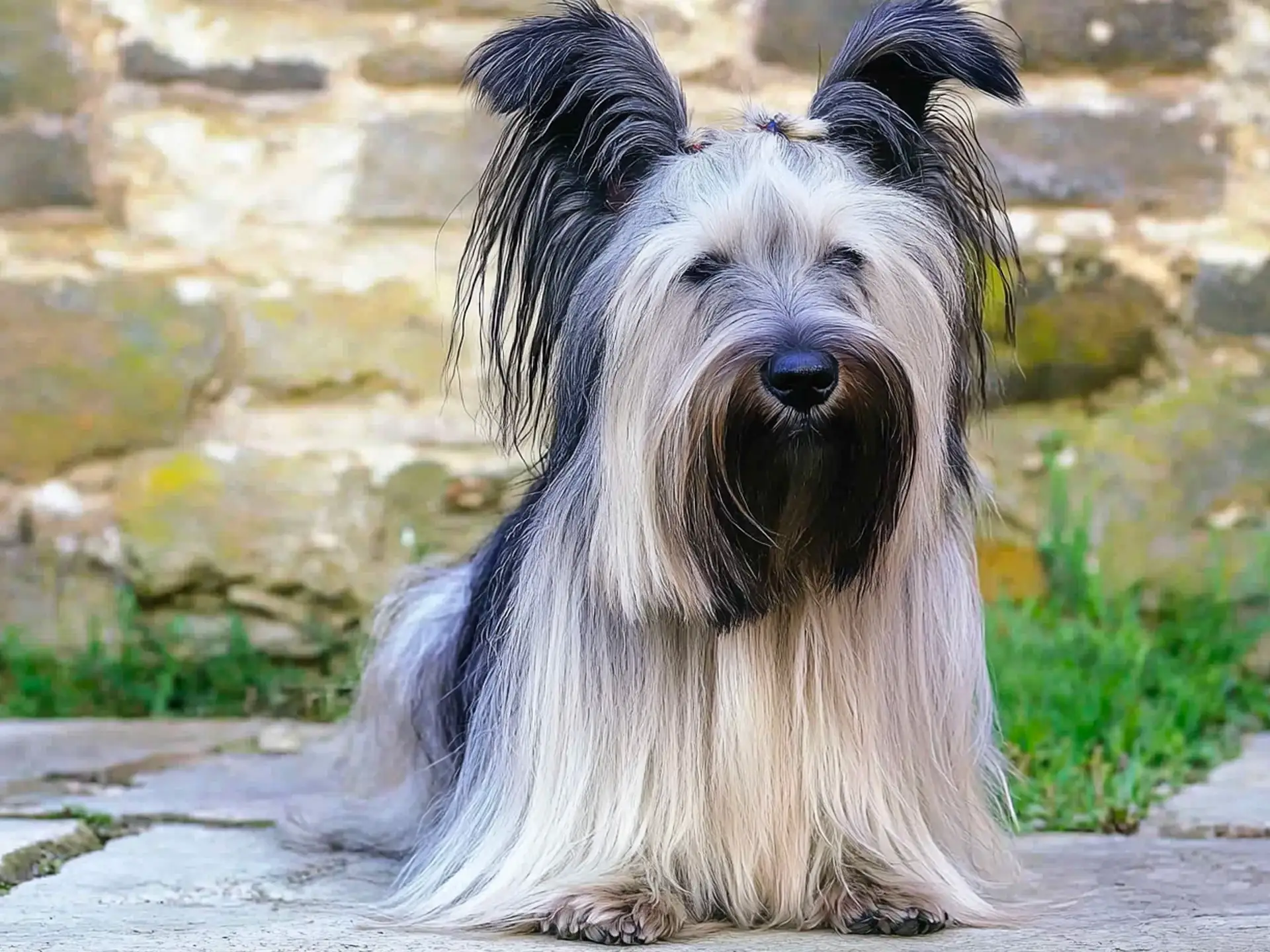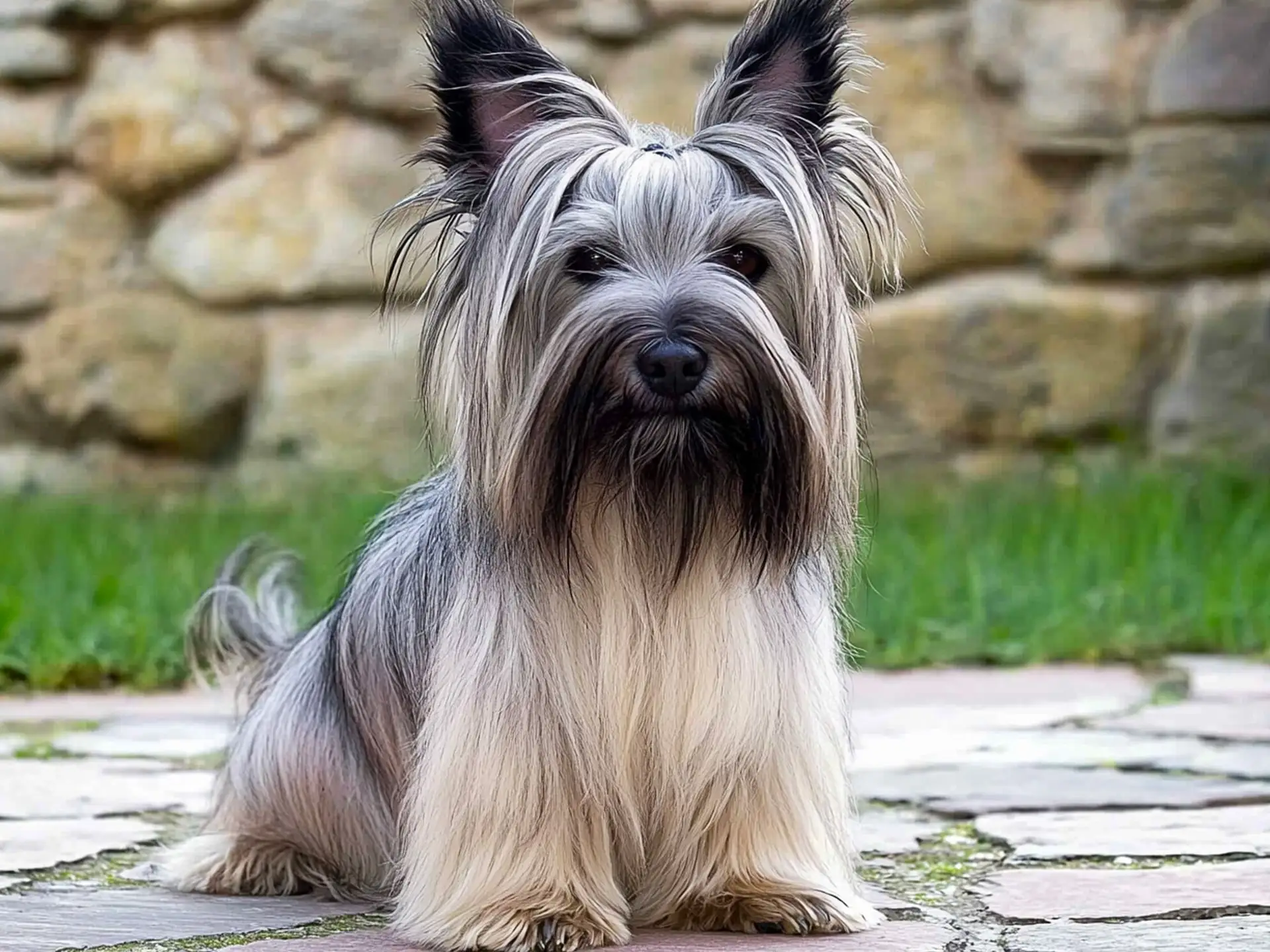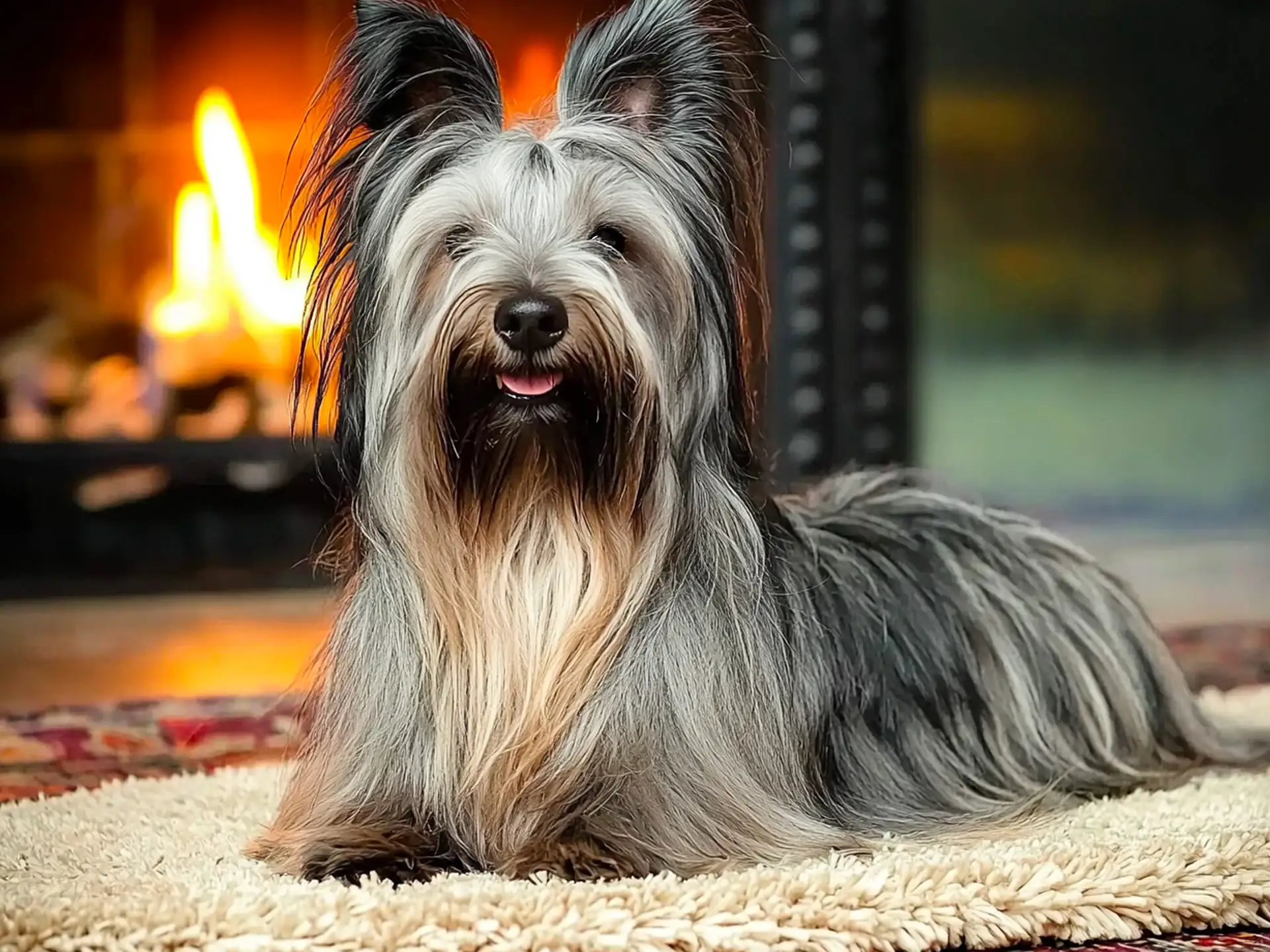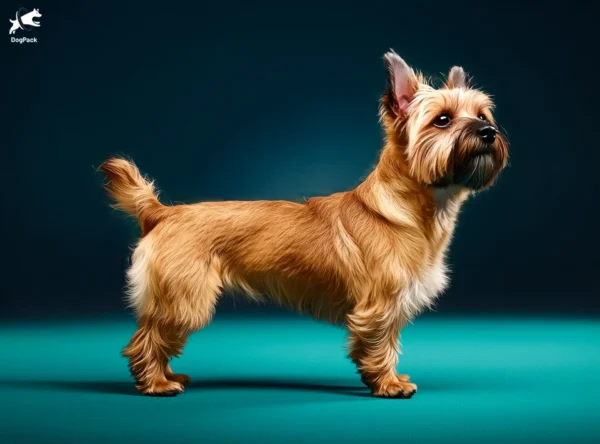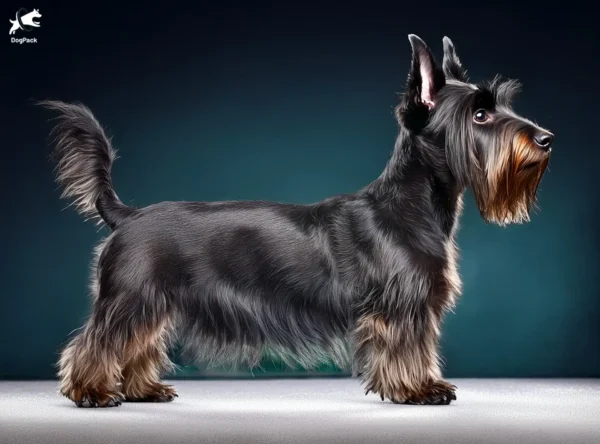Skye Terrier Dog Breed Info & Overview
Famed for its luxurious coat and unique silhouette, the Skye Terrier turns heads wherever it goes. This sturdy dog boasts a delightful mix of loyalty and spunk that has won over many admirers. From its Scottish origins to its modern-day charm, this rare terrier proves there’s more than meets the eye. Expect a companion that brings spirit to any home.
Characteristics
Pictures
Breed History
The story of this terrier begins on the picturesque Isle of Skye, off the coast of Scotland. Centuries ago, farmers and crofters needed a hardy pup to keep rodents and other pests in check. Over time, these dogs evolved into a distinct line known for their elegant coats, elongated frames, and determined personalities.
Legend has it that a shipwreck survivor introduced Spanish dogs to the island, crossing them with local terriers to produce today’s signature look. Royals and aristocrats quickly took notice, favoring these refined canines. By the 19th century, the breed gained popularity across Britain, bolstered by Queen Victoria’s fondness for its regal appearance and spirited demeanor.
Today, the Skye Terrier remains one of Scotland’s oldest and rarest native breeds. Although its numbers have diminished, dedicated enthusiasts continue to champion its lineage. The breed’s timeless elegance and striking silhouette stand as a reminder of its storied origins. Each generation of owners treasures these dogs, preserving an important piece of canine heritage.
Temperament, Personality
Loyalty forms the foundation of this terrier’s character, making it a devoted companion that enjoys spending quality time with its family. Don’t be surprised if it follows you from room to room, always eager to be near its favorite humans. This breed thrives on attention and will often form a particularly strong bond with one chosen person.
While generally calm indoors, this terrier can show a more assertive side when it senses unfamiliar guests. Early socialization is crucial to ensure it remains gracious and welcoming. Its curious nature leads it to investigate odd noises or strange scents, making it an attentive watchdog. Careful introductions with new faces can help cultivate a confident, well-rounded dog.
The Skye Terrier often gets along with older children who understand respectful handling. Younger kids might inadvertently overwhelm it, so supervised interactions are best. Although it can coexist with other pets, a slow and steady approach helps prevent territorial disputes. With consistent boundaries and plenty of social experiences, this breed becomes an affectionate, well-mannered household member.
Physical Characteristics
At first glance, this terrier’s defining feature is its long, flowing coat that parts down the middle of its back. Silky strands frame its face, often covering the eyes with a stylish fringe. Beneath that elegant exterior lies a surprisingly muscular body, supported by short yet sturdy legs. The breed’s well-feathered ears add to its distinctive appearance.
Standing around ten inches high, this dog sports a body length that can be twice its height. Prick ears stand tall and alert, while drop ears fold gracefully, both variations accepted in the show ring. Coat colors range from cream to black, often highlighted by lighter or darker shading. Each shade underscores its refined silhouette and low-slung stance.
The Skye Terrier’s tail complements its balanced profile, carried low with a slight upward curve at the tip. Strong forequarters help it navigate tough terrain, reflecting the breed’s working roots. While its overall build is compact, the coat gives an impression of grandeur. This timeless combination of grace and ruggedness makes it instantly recognizable among small dog breeds.
Health Issues
Like many long-backed breeds, this terrier may be prone to spinal issues, such as intervertebral disc disease. Keeping it at a healthy weight is essential to reduce stress on its spine. Regular checkups also help catch early signs of joint problems, which can develop if the dog overexerts itself or frequently jumps from high surfaces. Frequent use of ramps is recommended.
Eye conditions like cataracts can sometimes occur, especially in older dogs. Close monitoring by a veterinary ophthalmologist ensures any issues are managed swiftly. Some individuals may develop allergies, manifesting as itchy skin or ear infections. Consistent grooming and proper hygiene can minimize discomfort. Whenever possible, request health clearances from breeders to ensure a robust genetic background. Regular ear checks help too.
For the Skye Terrier, annual vet visits and routine diagnostic tests offer the best defense against emerging health concerns. Vaccinations, parasite prevention, and balanced nutrition further enhance longevity. Maintaining a consistent exercise schedule prevents weight gain, which can exacerbate skeletal issues. When owners remain proactive, this distinctive terrier can lead a vibrant, healthy life for many years.
Grooming Needs
While that luxurious coat is breathtaking to behold, it also demands consistent upkeep. Daily brushing helps prevent tangles, particularly behind the ears and along the belly where mats form quickly. A pin brush or comb works best for reaching through the dense undercoat. Skipping regular grooming sessions can lead to stubborn knots and a generally unkempt appearance.
Baths should occur every month or so, depending on your dog’s lifestyle and propensity for dirt. Use a gentle shampoo designed for long-coated breeds to avoid stripping natural oils. After a thorough rinse, a light conditioner can help keep hair smooth and manageable. Be sure to dry the coat well, as lingering moisture can cause skin irritations.
For the Skye Terrier, trimming around the paws and ear edges can keep its silhouette neat. Regular checks of the ears and eyes help catch signs of infection early, especially given the breed’s thick facial hair. Some owners opt for professional grooming services to maintain that classic parted look. Ultimately, a well-cared-for coat accentuates this terrier’s regal charm.
Exercise Requirements
Despite its smaller stature, this terrier benefits from daily walks and interactive play sessions. Aim for at least 30 minutes of outdoor activity, supplemented with puzzles or indoor games on rainy days. Regular leash walks allow it to explore scents and satisfy its natural curiosity. A bored terrier might resort to chewing or excessive barking, so structured exercise is key.
A fenced yard is ideal for short bursts of energy, but these dogs also adapt well to apartment living if given consistent outings. Keep sessions low-impact to protect their backs, and avoid encouraging them to jump off furniture. Incorporating light agility or trick training can offer both mental and physical stimulation without putting undue strain on their elongated frames.
The Skye Terrier thrives when it has daily opportunities to stretch its legs and engage its mind. Retrieving toys may not be its favorite pastime, but short tracking exercises appeal to its strong sense of smell. By rotating activities and offering new experiences, you can keep this clever companion motivated, happy, and physically conditioned.
Training Tips
Consistency is key for this terrier, which can exhibit a stubborn streak if given the chance. Begin obedience training early to establish boundaries and reinforce desirable behaviors. Positive reinforcement, including treats and praise, often yields better results than harsh corrections. A confident trainer who sets clear expectations will see more progress than one who wavers under those soulful eyes.
Socialization plays a vital role, especially given this dog’s protective nature around strangers. Early exposure to diverse environments, people, and animals helps it develop poise. Short, frequent training sessions are preferable to lengthy drills, preventing boredom and frustration. Praise small victories often, and be patient if progress seems slow—this breed can require extra time to absorb new lessons.
For the Skye Terrier, confidence-building exercises like gentle agility and scent work can enhance focus. Avoid forceful tactics that undermine trust and lead to resistance. Instead, incorporate reward-based strategies that celebrate positive behaviors. Gradually introducing distractions during training solidifies commands in real-world scenarios, ensuring this bright terrier becomes both a responsive partner and a loyal companion.
Nutrition, Diet
Due to its moderate size and weight, this terrier typically thrives on about one cup of high-quality kibble daily, divided into two meals. Opt for formulas rich in protein to support muscle tone, while moderate fat levels help maintain a healthy coat. Look for options containing glucosamine or chondroitin to promote joint health, especially beneficial for a long-backed breed. These nutrients keep mobility steady.
Some individuals may be prone to weight gain if overfed or under-exercised. Monitor your terrier’s physique using the body condition scoring system, adjusting portions as needed. Including omega-3 fatty acids from fish oil or flaxseed can enhance coat luster and reduce inflammation. For snacks, focus on low-calorie treats like carrot sticks or plain, cooked pumpkin to avoid extra pounds.
For the Skye Terrier, tailoring the diet to its life stage—puppy, adult, or senior—ensures appropriate nutrient levels. Puppies need extra protein and calories for growth, while older dogs benefit from joint supplements and reduced fat. Always measure meals to maintain a lean body shape. Regular weigh-ins and vet consultations help you fine-tune feeding plans for optimal health.
Adoption, Breeders
Skye Terriers are rare, so it’s essential to locate a responsible breeder who prioritizes health testing and proper socialization. Ask for documentation of genetic screenings and spend time interacting with any parent dogs on-site. A reputable breeder will also guide you on grooming and feeding specifics, ensuring your new companion transitions smoothly into its forever home.
For those considering adoption, breed-specific rescue groups can be a great resource. Shelters and local rescue organizations occasionally have Skye Terriers in need of loving homes. The Skye Terrier Club of America offers detailed information on available rescues, while Petfinder also lists potential matches. Adopting an older dog can be especially rewarding, as many arrive with basic training.
Whether you buy from a top-notch breeder or adopt through a rescue, always request references or testimonials from previous owners. Reputable sources invest in each puppy’s upbringing, ensuring socialization and early healthcare. Spend time researching credentials and reading reviews online. A mindful approach to adoption or purchase leads to a happier, healthier partnership between you and your future companion.
Family Pet?
Families seeking a smaller dog with a big heart may find this terrier an excellent match. Known for its fierce loyalty, it thrives when it’s part of daily routines and social gatherings. Households with older children tend to do best, as this breed appreciates calm handling. Although reserved with strangers, it usually warms up once trust is established.
Supervised playtime teaches youngsters how to respect the dog’s space and avoid tugging on its coat. If the children learn to handle it gently, this companion can be surprisingly playful. However, boisterous behavior or accidental roughhousing might spook a sensitive pup. Setting clear boundaries for all family members ensures positive interactions, reinforcing harmony between kids and canines.
In a multi-pet household, the Skye Terrier can adapt if introduced properly. Gradual, supervised meetings help avert conflicts over territory or toys. Patience and consistency encourage peaceful coexistence, but don’t be alarmed if initial wariness appears. With time and mutual respect, many families find that their terrier develops strong bonds with both two-legged and four-legged companions.
Right For You?
Whether you prefer a tranquil apartment setting or a cozy suburban home, this terrier can adapt well if you meet its social and exercise requirements. Prospective owners should be prepared for regular grooming and the possibility of stubborn moments during training. It’s not the ideal breed for someone unwilling to invest time and patience into building a strong relationship.
Its moderate energy level suits various lifestyles, but mental enrichment remains non-negotiable. Games, puzzle feeders, and trick training keep your terrier engaged. If you relish a loyal dog that enjoys quiet companionship, this breed might be a good match. However, owners who want a highly outgoing dog or an off-leash adventurer may need to look elsewhere.
In essence, the Skye Terrier is best suited for those seeking a devoted friend with a dash of independence. Potential owners who embrace grooming routines and patient training will be rewarded with a steadfast companion. If you’re ready for a terrier that offers equal parts sophistication and spunk, this breed could be your perfect long-haired sidekick.
Conclusion
Deciding to welcome this terrier into your life means embracing a unique blend of elegance and loyalty. While the grooming demands and occasional stubborn streak might require extra patience, the rewards are plentiful. Whether you live alone or share your home with a family, this small yet spirited companion can weave itself into daily routines and hearts alike. Consistent training, a balanced diet, and regular exercise will help it thrive. For those prepared to nurture its protective instincts with gentle guidance, this rare Scottish breed can offer years of companionship and joy. Ultimately, the Skye Terrier appeals to owners who appreciate a breed that stands out both for its striking appearance and unwavering devotion.
FAQs
-
Why do Skye Terriers have such long ears and coats?
The Skye Terrier’s long ears and coat were developed to protect them from harsh Scottish weather and rough terrain. Their flowing double coat acts as insulation, while their large feathered ears shield them from wind and debris while hunting.
-
Do Skye Terriers form strong bonds with one person?
Yes, Skye Terriers are known as “one-person dogs”, forming deep loyalty to a single owner. They can be reserved or aloof with strangers but show deep affection and devotion to their trusted person, often following them around and staying close.
-
Are Skye Terriers good off-leash dogs?
No, Skye Terriers have a strong prey drive and may chase small animals if given the chance. Due to their independent nature, off-leash walking is risky unless in a secured area. Reliable recall training is difficult, so they do best on a leash.
-
Why are Skye Terriers considered a rare breed?
Despite their rich history and royal connections, Skye Terriers are now one of the rarest terrier breeds, even in the UK. Their low numbers are due to low breeding populations, modern lifestyle changes, and competition from more popular terriers.
-
Are Skye Terriers prone to back problems?
Yes, due to their long, low body structure, Skye Terriers are at risk for intervertebral disc disease (IVDD). Avoiding high-impact activities like jumping and maintaining a healthy weight can help reduce the risk of spinal issues.
Breed Ratings
Quick to learn but can be willful, so consistent, positive training methods are key to unleashing this breed’s potential.
Enjoys interactive games and gentle roughhousing but may prefer short bursts of activity over extended play sessions.
Needs daily walks and mental stimulation, yet can relax indoors if exercise requirements are met consistently.
While not extreme shedders, their long coats do release some hair; regular brushing helps keep it manageable.
Historically used to hunt vermin, but modern individuals typically have a mild drive; supervision around small pets is advised.
The flowing double coat demands extensive brushing and occasional trimming, making grooming more involved than most breeds.
Responsive when motivated with treats and praise, but can be stubborn. Short, upbeat sessions yield better results.
Strongly bonds with its family and may become anxious if left solo for long periods without enrichment.
Will alert you to visitors or strange noises but typically quiets down once it feels the situation is under control.
Rarely a drooler; any excess saliva generally indicates excitement, stress, or an underlying health concern.
Gets along with well-socialized canines but may need gradual introductions, especially if both dogs have strong personalities.
Generally robust but prone to spinal issues and eye problems; regular vet checks and weight management are crucial.

